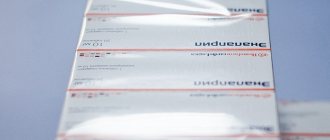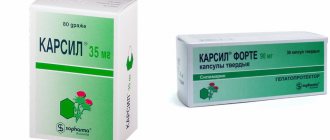Pharmacological properties of the drug Normatens
Combined antihypertensive drug. The mechanism of the drug's hypotensive effect includes a moderate diuretic effect and inhibition of the activity of the adrenergic system at the peripheral and central levels. Dilates blood vessels and reduces heart rate. The absorption of individual components of the drug in the digestive tract is: reserpine - about 30–40%, clopamide - almost 60%, dihydroergocristine - ≤50%. The maximum concentration in the blood plasma is achieved: reserpine - after 2 hours, clopamide - after 2 hours, dihydroergocristine - after 1 hour. The components of Normatens distribute well in the tissues of the body. Reserpine and dihydroergocristine are metabolized in the liver to inactive metabolites, which are excreted in urine and feces. Clopamide does not undergo significant hepatic metabolism and is excreted mainly in the urine.
Instructions for use NORMATENS
Normatens is a combined antihypertensive drug containing 3 complementary components that reduce blood pressure:
- reserpine, clopamide and dihydroergocristine. This combination allows the use of smaller doses of individual active ingredients, reduces the risk associated with side effects, and also simplifies the dosing of medications.
Reserpine is a rauwolfia alkaloid, a sympatholytic with neuroleptic and antihypertensive effects. Penetrating into the presynaptic endings of postganglionic sympathetic fibers, it releases norepinephrine from vesicles while simultaneously disrupting its reverse transport and enhancing the process of MAO inactivation. Causes depletion of neurotransmitter reserves and a persistent decrease in blood pressure. Helps reduce the concentration of dopamine, serotonin and other neurotransmitters in neurons, providing an antipsychotic effect. Weakens the effect of sympathetic innervation on the cardiovascular system, reduces heart rate and total peripheral vascular resistance; maintains the activity of the parasympathetic nervous system; deepens and enhances physiological sleep, inhibits interoceptive reflexes. Increases peristalsis of the gastrointestinal tract, increases the production of hydrochloric acid in the stomach; slows down metabolic processes in the body; reduces and deepens respiratory movements, causes miosis, hypothermia; reduces metabolic rate. Has a positive effect on lipid and protein metabolism in patients with arterial hypertension and coronary atherosclerosis; increases renal blood flow, enhances glomerular filtration. Clopamide is a “loop” sulfonamide diuretic of moderate potency, similar to the action of thiazides. Reduces the reabsorption of sodium ions in the cortical segment of the ascending loop of Henle, as well as in the convoluted distal tubules, which causes increased diuresis and natriuresis, as well as a decrease in blood pressure. Inhibition of the reabsorption of sodium ions increases kaliuresis and can lead to hypokalemia.
Dihydroergocristine belongs to the group of hydrogenated ergot alkaloids. It is an agonist of dopaminergic and serotonergic receptors and an antagonist of alpha-adrenergic receptors. Due to its effect on the central nervous system, it reduces the tone of the muscles of blood vessels, reduces overall peripheral vascular resistance, lowering blood pressure. In addition, dihydroergocristine suppresses baroreceptor reflexes and reduces reflex tachycardia.
The hypotensive effect of the drug exceeds the hypotensive effect of each of the components separately and the effect of any combination of two components; onset of action is on days 4-7, a persistent hypotensive effect is achieved after 1-4 weeks.
Use of the drug Normatens
It is recommended to begin treatment by prescribing 1 tablet once a day during or after meals. If the hypotensive effect is insufficient, the dose of the drug is increased to 2 tablets per day (1 tablet every 12 hours), and in exceptional cases, 1 tablet is prescribed 3 times a day (every 8 hours). With long-term treatment, if a satisfactory effect is achieved, it is recommended to switch to maintenance treatment, 1 tablet once a day, and some patients can take 1 tablet every other day.
Pharmacological properties
Doxylamine succinate. H1-histamine receptor blocker from the ethanolamine group. The drug has a hypnotic, sedative and M-anticholinergic effect. Reduces the time to fall asleep, increases the duration and quality of sleep, without changing the sleep phases. Duration of action – 6-8 hours. Pyridoxine hydrochloride. Vitamin B6 (pyridoxine hydrochloride) – participates in metabolism; necessary for the normal functioning of the central and peripheral nervous system. Entering the body, it is phosphorylated, converted into pyridoxal-5-phosphate and is part of the enzymes that decarboxylate amino acids. Participates in the metabolism of tryptophan, methionine, cysteine, glutamic and other amino acids, stimulates the formation of red blood cells, and participates in the biosynthesis of many neurotransmitters (dopamine, norepinephrine, adrenaline, histamine, serotonin). Plays an important role in histamine metabolism. Helps normalize lipid metabolism. Isolated pyridoxine deficiency is very rare, mainly in children on special artificial nutrition (manifested by diarrhea, cramps, anemia, and peripheral neuropathy may develop). Together with cyanocobalamin, it eliminates the inflammatory process in nervous tissue and accelerates its regeneration.
Pharmacokinetics
Doxylamine succinate. Absorption is high, metabolized in the liver. Penetrates well through histohematic barriers (including the blood-brain barrier). 60% is excreted unchanged by the kidneys, partially through the gastrointestinal tract. Pyridoxine hydrochloride. Rapidly absorbed in the small intestine. Metabolized in the liver to form pharmacologically active metabolites (pyridoxal phosphate and pyridoxaminophosphate). Penetrates well into all tissues; accumulates mainly in the liver. Penetrates the placenta and is secreted into breast milk. It is excreted by the kidneys and also during hemodialysis.
Indications for use
- sleep disturbance, insomnia; — hypo and avitaminosis of B vitamins (treatment and prevention); — anemia of various origins; - symptomatic treatment of diseases of the nervous system of various origins: neuritis, neuralgia, myalgia, peripheral paresis and paralysis, retrobulbar neuritis, facial nerve paresis, lumbago, plexitis, amyotrophic lateral sclerosis, cerebral palsy, peripheral nerve injuries; - vitamin deficiency when following restrictive diets, nutritional imbalances, fever, chronic diseases, intense physical activity and increased fatigue, in the postoperative period.
Mode of application
The recommended dose is 1/2 to 1 tablet per day. Take the tablets with a small amount of liquid. The tablets should be taken before bedtime. If treatment is ineffective, on the recommendation of a doctor, the dose can be increased to 2 tablets per day.
Side effects
Allergic reactions, nausea, daytime drowsiness, dry mouth, accommodation paresis, constipation, urinary retention, rarely - convulsions.
Contraindications
- hypersensitivity to the drug and its derivatives; - angle-closure glaucoma; - prostatic hyperplasia, urinary retention; - peptic ulcer of the stomach and duodenum; - cardiac ischemia.
Drug interactions
Doxylamine succinate When used simultaneously with barbiturates, benzodiazepines, clonidine, opioid analgesics, neuroleptics, anxiolytics, the inhibitory effect on the central nervous system is enhanced. May reduce emetic response to apomorphine. When taken with m-anticholinergic drugs, the risk of side effects increases: dry mouth, urinary retention. Since alcohol increases the sedative effect, it is necessary to avoid drinking alcoholic beverages and medications containing alcohol. Pyridoxine hydrochloride Enhances the effect of diuretics; weakens the activity of levodopa. Combined with cardiac glycosides (pyridoxine helps increase the synthesis of contractile proteins in the myocardium), with glutamic acid and potassium and magnesium aspartate. Pharmaceutically incompatible with thiamine and cyanocobalamin.
special instructions
In case of severe liver damage, the drug may cause a deterioration in liver function. Impact on the ability to drive a car and operate machinery. Recommended with caution. The drug should be stored out of the reach of children and not used after the expiration date. The drug is safe during pregnancy and lactation.
Overdose
Symptoms: increased adverse reactions. Treatment: symptomatic. There is no specific antidote.
Storage conditions
Store in a dry and dark place, at a temperature not exceeding 25°C.
Best before date
3 years
Vacation conditions
According to the recipe
Attention! The description of the drug on this page is simplified. Before purchasing and using the drug, consult your doctor or pharmacist, and also read the instructions approved by the manufacturer. Information about the drug is provided for informational purposes only and should not be used as a guide to self-medication. ATTENTION! This section is provided for informational purposes only and is not a catalog or price list of our company. To obtain information about the availability of drugs, call + 99871 202 0999 Pharmacy Network Helpline 999.
Special instructions for the use of Normatens
For timely detection of water-electrolyte imbalances, periodic monitoring of potassium levels in the blood is recommended, as well as following a diet rich in potassium (carrots, spinach, dried fruits, fresh vegetables, cheese, fish). Periodic monitoring of blood pressure and heart rate is recommended, especially during the period of selecting the optimal dose of the drug. The effect of the drug develops relatively slowly; The dose should not be increased to the maximum during the initial period of use due to the possibility of severe hypotension. Prescribe with caution to elderly patients, with impaired liver or kidney function, in persons with asthma and COPD. The drug should not be used in children.
Normatens dragee No. 20x1
Name
Normatens.
Description
The dragee is white or almost white, without scratches, stains or cracks. The shape of the dragees is round, biconvex.
Main active ingredient
Reserpine + dihydroergocristine + clopamide.
Release form
Dragee.
Pharmacological group
Antihypertensive drugs in combination with diuretics. Rauwolfia alkaloids in combination with diuretics. ATX code C02LA51.
Pharmacological properties
Normatens is a combined antihypertensive drug containing 3 complementary components that lower blood pressure: reserpine, clopamide and dihydroergocristine. This combination allows the use of smaller doses of individual active ingredients, reduces the risk associated with side effects, and also simplifies the dosing of medications. Reserpine is a rauwolfia alkaloid, a sympatholytic with neuroleptic and antihypertensive effects. Reserpine is part of the class of adrenergic neuronal blockers. Causes depletion of neurotransmitter released from adrenergic vesicles of the presynaptic structure. Reserpine also prevents the uptake and storage of catecholamines and serotonin in the central and peripheral nervous systems. As a result of this, it will reduce the content of catecholamines in the nervous system and peripheral tissues. Reserpine causes reflex vagotonia. The consequences of reserpine are vasodilation, slowing of heart rate and a long-term decrease in blood pressure. Clopamide is a diuretic of moderate potency, similar to the action of thiazides. Reduces the reabsorption of sodium ions in the cortical segment of the ascending loop of Henle, as well as in the convoluted distal tubules, which causes increased diuresis and natriuresis, as well as a decrease in blood pressure. Inhibition of the reabsorption of sodium ions increases kaliuresis and can lead to hypokalemia. Dihydroergocristine belongs to the group of hydrogenated ergot alkaloids. It is an agonist of dopaminergic and serotonergic receptors and an antagonist of alpha-adrenergic receptors. Due to its effect on the central nervous system, it reduces the tone of the muscles of blood vessels, reduces overall peripheral vascular resistance, lowering blood pressure. In addition, dihydroergocristine suppresses baroreceptor reflexes and reduces reflex tachycardia.
Indications for use
Primary and secondary arterial hypertension, if monotherapy does not achieve sufficient antihypertensive effect. The drug can be used in combination with other antihypertensive drugs such as beta blockers and vasodilators.
Directions for use and doses
The dosage is determined by the doctor individually for each patient. It is recommended to start treatment with 1 tablet taken once a day. The pills should be taken during or immediately after meals. If necessary (only after the recommendation of a doctor), you can increase the dose of the drug up to 3 times a day (every 8 hours) by 1 tablet (the daily dose should not exceed 3 tablets). It must be remembered that, given the mechanism of action and pharmacological properties of the individual components of the drug, possible hypotensive ineffectiveness can be discussed no earlier than after about 14 days from the start of use and, therefore, during this period the initial dose should not be increased without urgent need. The dose should be increased gradually. Most often, the most effective maintenance dose is 1 tablet once a day. For some patients, an effective maintenance dose is 1 tablet taken every other day. However, sometimes it may be necessary to use 2 tablets in several doses, and in exceptional cases - 3 tablets in several doses (higher doses should not be taken). The pills should be taken during or immediately after meals. Children: Not applicable. Dosage for Elderly Patients: No dosage adjustment is necessary, but due to the increased risk of hypotension and electrolyte imbalance, extreme caution is advised when using the product. Dosage for patients with renal and hepatic insufficiency: The use of this drug in patients with severe hepatic and renal insufficiency (creatinine clearance
Use during pregnancy and lactation
Taking into account the potential risk to the fetus, the use of the drug during pregnancy is contraindicated. You should not take the drug during breastfeeding.
Impact on the ability to drive vehicles and maintain moving mechanisms
Normatens affects the ability to drive vehicles and maintain moving mechanisms. Especially at the beginning of treatment and after increasing the dose of the drug, a feeling of severe weakness and orthostatic hypotension may occur, which impair the ability to drive vehicles and operate moving mechanisms.
Precautionary measures
The dosage is determined by the doctor individually for each patient. Periodic monitoring of blood pressure and heart rate is indicated so that the doctor can determine the optimal dose of the drug. During treatment, certain undesirable effects may occur that should be taken into account: a drug with a relatively slow effect that lowers blood pressure; the dose should not be significantly increased in the initial period of use, due to the possibility of an excessive drop in pressure; Particular caution should be exercised when used with other drugs that may lower blood pressure (see: Drug interactions); during use of the drug Normatens, the level of glucose and uric acid in the blood serum may increase (periodic monitoring of these parameters is indicated, especially in patients with impaired glucose tolerance and hyperuricemia); caution should be exercised and, if necessary, reduce the dose of the drug in patients with renal and (or) liver failure; do not use in case of severe renal failure (creatinine clearance
Contraindications
Hypersensitivity to sulfonamides, reserpine and ergot alkaloids, or any other component of the drug; depression, epilepsy, Parkinson's disease, pheochromocytoma, treatment with MAO inhibitors, gastric and duodenal ulcers, erosive gastritis, ulcerative colitis, angina pectoris, chronic heart failure, severe bradycardia, AV block, intraventricular block, recent myocardial infarction, arterial hypotension, severe cerebral atherosclerosis, Addison's disease, hypokalemia, hyponatremia, hypochloremia, hyperuricemia with clinical manifestations, glaucoma, hematopoietic disorders, bronchial asthma, severe liver and kidney failure (creatinine clearance below 30 ml/min), nephritis, uremia, nephrosclerosis. Pregnancy, breastfeeding period. Childhood. With caution: elderly patients, patients with diabetes mellitus and gout.
Compound
Composition of active ingredients in 1 tablet: Clopamide - 5.0 mg Dihydroergocristine - 0.5 mg in the form of dihydroergocristine methane sulfonate - 0.58 mg Reserpine - 0.1 mg Excipients: lactose, potato starch, povidone, talc, magnesium stearate, sucrose, gum arabic, a mixture of white beeswax (E901) and carnauba wax (E903).
Overdose
Symptoms of drug overdose: nausea, vomiting, diarrhea, headaches, feeling hot and thirsty, hypokalemia, myasthenia gravis, bradycardia, hypotension, heart rhythm disturbances, depression, disturbances of consciousness (confusion), coma. Shortly after an overdose, gastric lavage may be useful and the use of activated charcoal to remove unabsorbed drug from the body. It is necessary to monitor cardiac function, blood pressure and water-electrolyte balance and provide symptomatic treatment if necessary.
Side effect
Usually the drug is easily tolerated. From the nervous system: Myasthenia gravis, weakness, headache, dizziness, drowsiness, weakness, anxiety, impaired concentration, insomnia, extrapyramidal disorders (tremor, stupor, Parkinson's syndrome). Since the drug contains reserpine, you should be aware of the possibility of depressive reactions (including suicidal tendencies) and depressive syndrome when using reserpine at a dose of 1 mg per day (10 Normatens tablets). From the gastrointestinal tract: Nausea, vomiting, dry mouth, abdominal pain, diarrhea, exacerbation of peptic ulcer, loss of appetite; in isolated cases - the appearance of ulcers on the mucous membrane of the stomach and duodenum, gastrointestinal bleeding when using reserpine at a dose of 1 mg per day (10 Normatens tablets). From the cardiovascular system: Orthostatic hypotension, bradycardia, cerebrovascular disorders. From the respiratory system: Rhinitis, hyperemia and swelling of the nasal mucosa, the appearance of bronchospasm in patients with bronchial asthma or broncho-obstructive syndrome. From the hematopoietic system: Thrombocytopenia with symptoms of hemorrhagic diathesis. Impaired water-electrolyte balance in the form of hypokalemia, increased concentrations of glucose and uric acid in the blood. Allergic reactions: skin rash, itching. Laboratory indicators: hypokalemia, hypomagnesemia, hypocalcemia, metabolic alkalosis, hyperuricemia, hyperglycemia, slight increase in triglycerides, cholesterol. Others: galactorrhea. With long-term use in large doses - paresthesia, decreased libido, decreased potency, gynecomastia, urination disorders, spasm of accommodation, conjunctival hyperemia, hypothermia.
Storage conditions
Store in original packaging at a temperature not exceeding 25°C. Do not use the drug after the expiration date indicated on the package. The drug should be stored in a place inaccessible and hidden from children.
Buy Normatens tablets in blisters, pack No. 20x1 in the pharmacy
Price for Normatens tablets in pack No. 20x1
Instructions for use for Normatens dragee in blister pack No. 20x1



